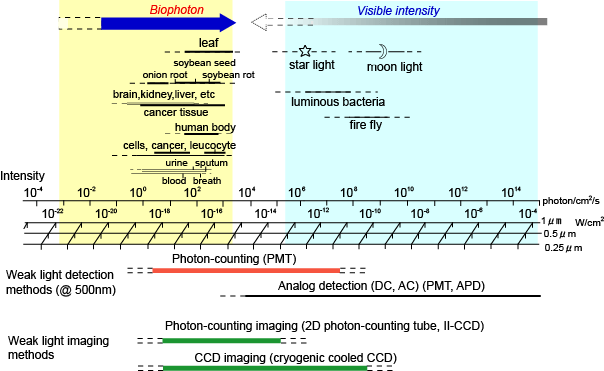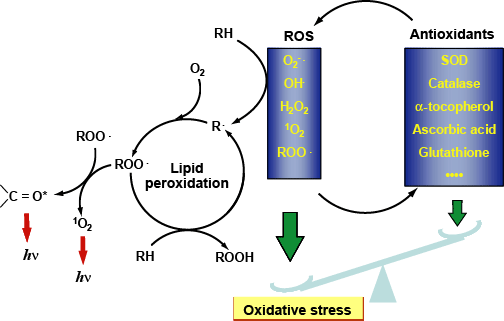
[Overview]
It has recently been accepted that all living organisms emit ultraweak light during ordinary metabolic processes, a phenomenon referred to as biophoton emission. Originating from the chemical excitation of molecules undergoing oxidative metabolism, the intensity of biophoton emission is typically less than approximately 10-16W/cm2, and is observed within the visible wavelength range. However, it is distinct from thermal radiation arising from body temperature, which is approximately 1/100 or 1/1000 less intense than biophoton emission within the same wavelength range. Biophoton phenomena, evident in various biological materials and observed under a multitude of conditions, have been explored from cellular or subcellular levels up to the level of individual organisms, following the advancement of highly sensitive photon detection techniques. These studies propose the potential utility of biophotons, as they mirror the pathophysiological states of organisms at each level of biological hierarchy, suggesting their relevance for extracting diagnostic biomedical information. Figure 1 presents the range of biophoton emission intensity.

Fig. 1 Intensity range of biophoton emission
[Mechanism and characteristics of biophoton emisssion]
A biophoton is a spontaneous photon emission that occurs without any external photo-excitation. It is generated through the chemical excitation of internal biochemical processes underlying cellular metabolism. Usually, the biochemical reaction process involved is related to oxidative metabolism, which is accompanied by the generation of reactive oxygen species (ROS). Many instances of biophoton phenomena have been examined in relation to radical reactions triggered by ROS generation and subsequent cellular dysfunction caused by ROS. For example, during lipid peroxidation, excited species such as carbonyls and singlet oxygen are produced within a radical chain reaction triggered by ROS (according to the Russel mechanism). These excited species, or other fluorescent molecules stimulated through energy transfer, are believed to result in biophoton emission. In general, biophoton emission is differentiated from common bioluminescence phenomena, such as those observed in fireflies. The difference can be located in the luminescent mechanism, with photon-yielding efficiency yielding an intensity difference of over 1000 times. Whereas bioluminescence typically originates from enzymatic reactions, like the luciferin-luciferase system, biophoton emission is caused by various mechanisms and species accompanying inherent oxidative metabolism. Oxidative stress through ROS generation has been widely recognized as a contributing factor to various diseases. These are often derived from oxidative alterations of cellular constituents such as lipids, proteins, nucleic acids, and enzymes. Therefore, biophoton emission may serve as an indicator of pathological states. For instance, it has been reported that UV irradiation on the skin, the administration of lipid peroxide or carcinogens, and other conditions linked to oxidative stress, result in an increase in biophoton intensity. The aging process is also known to amplify biophoton emission. This suggests that biophoton emission serves as an marker of imbalances between oxidation and antioxidative protection, illustrated as an excess production of ROS and/or a decline in antioxidation activity. The detection of biophoton emission can provide real-time characterization of a variety of biological samples, from individual organisms to the cellular and metabolite levels of matter.

Fig.2 Schematic illustration of an example of a biophoton mechanism (Lipidperoxidation process)